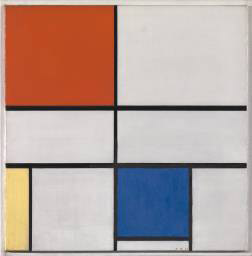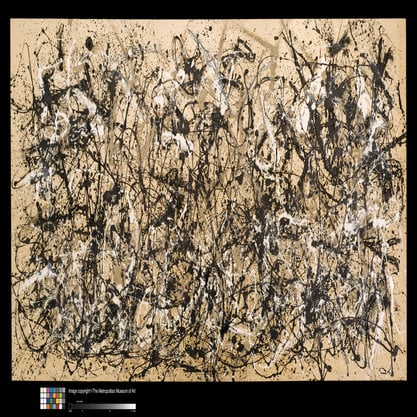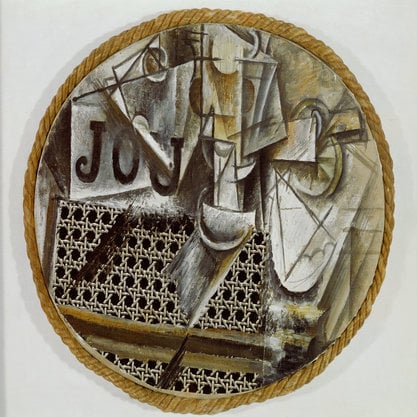Article
Mondrian, Piet (1872–1944) By Jones, Peter
Article
Abstract
The Dutch artist Piet Mondrian was one of the pioneers of abstract art, producing some of the most radical painting of the 20th century. The early influence of Cubism led him to adopt a semi-abstract linear style, as in the paintings of trees and buildings he made in Paris and Holland over 1912–1914. During the inter-war years, Mondrian developed an esoteric theory of art and an austere style of geometric abstraction he called Neo-Plasticism. In this work, for which he is best known, Mondrian abandoned all reference to nature and aimed to express a higher reality beyond the world of appearances. He reduced his painting to basic elements and their interplay: black horizontal and vertical lines, planes of primary colors, grey and white as exemplified in Composition C (III) with Red, Yellow and Blue from 1935. His final paintings, made in America in the early 1940s, are characterized by vibrant grids animated by small colored squares reflecting an interest in the syncopated rhythms of popular music and urban life. Mondrian was also a consummate draughtsman, prolific writer and member of the influential De Stijl [The Style] group, which sought to reform the arts and society.
A revised and expanded version of this article is available here.
The Dutch artist Piet Mondrian was one of the pioneers of abstract art, producing some of the most radical painting of the 20th century. The early influence of Cubism led him to adopt a semi-abstract linear style, as in the paintings of trees and buildings he made in Paris and Holland over 1912–1914. During the inter-war years, Mondrian developed an esoteric theory of art and an austere style of geometric abstraction he called Neo-Plasticism. In this work, for which he is best known, Mondrian abandoned all reference to nature and aimed to express a higher reality beyond the world of appearances. He reduced his painting to basic elements and their interplay: black horizontal and vertical lines, planes of primary colors, grey and white as exemplified in Composition C (III) with Red, Yellow and Blue from 1935. His final paintings, made in America in the early 1940s, are characterized by vibrant grids animated by small colored squares reflecting an interest in the syncopated rhythms of popular music and urban life. Mondrian was also a consummate draughtsman, prolific writer and member of the influential De Stijl [The Style] group, which sought to reform the arts and society.


© 2017 Mondrian/Holtzman Trust © Tate 2017
Piet Mondrian was born in 1872 to a middle-class Calvinist family in Amersfoort, the Netherlands. In 1892, he entered Amsterdam’s Rijksacademie to study art. His early work (1895–1910) was predominately landscapes, influenced successively by 19th century naturalism, Impressionism, Symbolism and Neo-Impressionism. He also experimented with pointillist-type optical effects and the vivid coloring of Fauvism as in the 1908 painting Windmill in Sunlight. He had his first retrospective in a 1909 group show at Amsterdam’s Stedelijk Museum. In 1911, Mondrian had an epiphanic encounter with Cubism which led him to adopt its faceting, shallow pictorial space and muted coloring, but not its multiple perspectives, preferring a single viewpoint. Mondrian’s work became increasingly non-naturalistic and rarefied: for instance, the 1915 painting Composition 10 in Black and White: Pier and Ocean, in which the landscape is reduced to an overall pattern of cruciform fragments.
Mondrian had a keen interest in philosophy and religion. A major influence on his art was Theosophy, a popular mystical creed that advocated spiritual evolution and the idea of a latent universal order—something Mondrian wanted to evoke through the harmonious yet dynamic arrangement of line and color. In 1917, Mondrian, with the Dutch artist and critic Theo van Doesburg, founded the journal De Stijl as a platform for their ideas and an idealistic avant-garde group of the same name. The group extended its principle of abstraction beyond art to architecture and design in order to unify them and to engender social harmony and cultural renewal in the wake of World War I. From 1919 to 1938, Mondrian lived mostly in Paris, developing his Neo-Plasticism abstraction, composing his evangelical-style writing, and exhibiting across Europe—thus affirming his position as a key player in the international avant-garde. Mondrian worked intuitively and meticulously, often spending months on a single canvas. In 1931, he joined the Paris-based Abstraction-Création group, making friends with the British modernist Ben Nicholson. In 1936, Mondrian was part of the group show Cubism and Abstract Art at MOMA in New York. He spent 1938–1940 in London, supported by Nicholson. To escape the war in Europe, Mondrian moved to New York in 1940, where he had a profound effect on American artists, especially the Abstract Expressionists. While in New York, Mondrian developed a number of technical innovations, such as the use of colored adhesive tape, which allowed him to produce work of increasing complexity and vitality, as in Broadway Boogie-Woogie of 1942–1943, the last painting he completed before his death in 1944.


